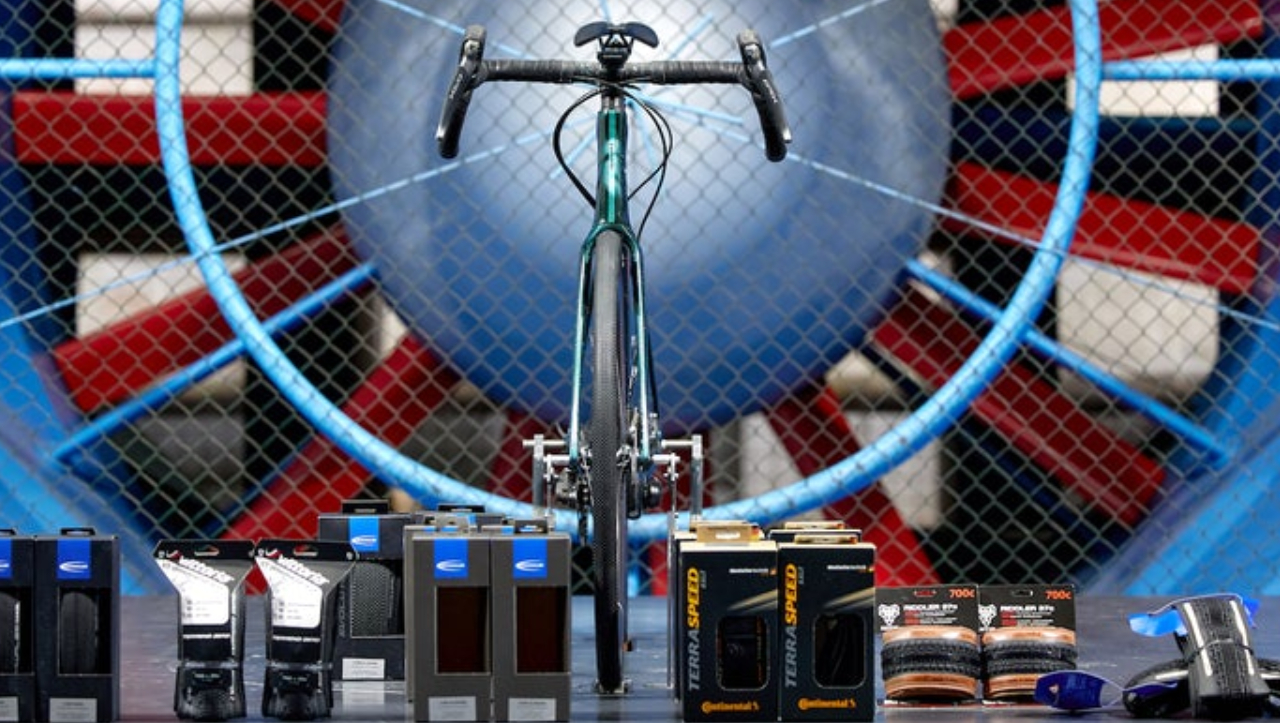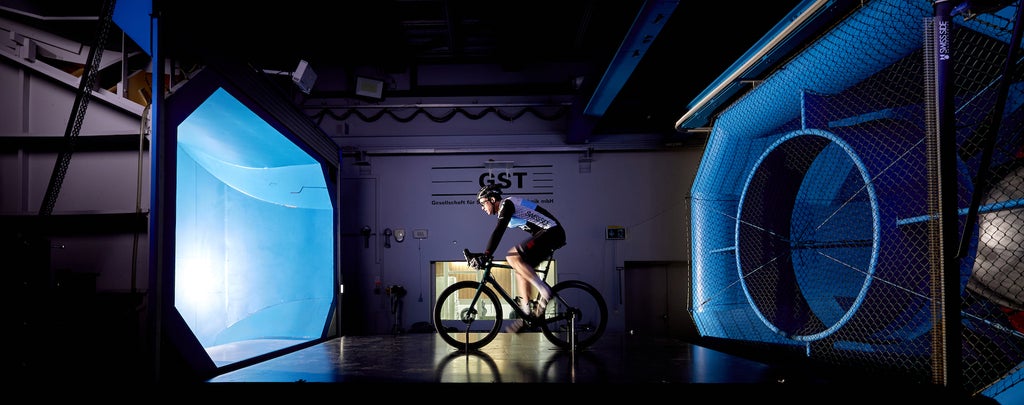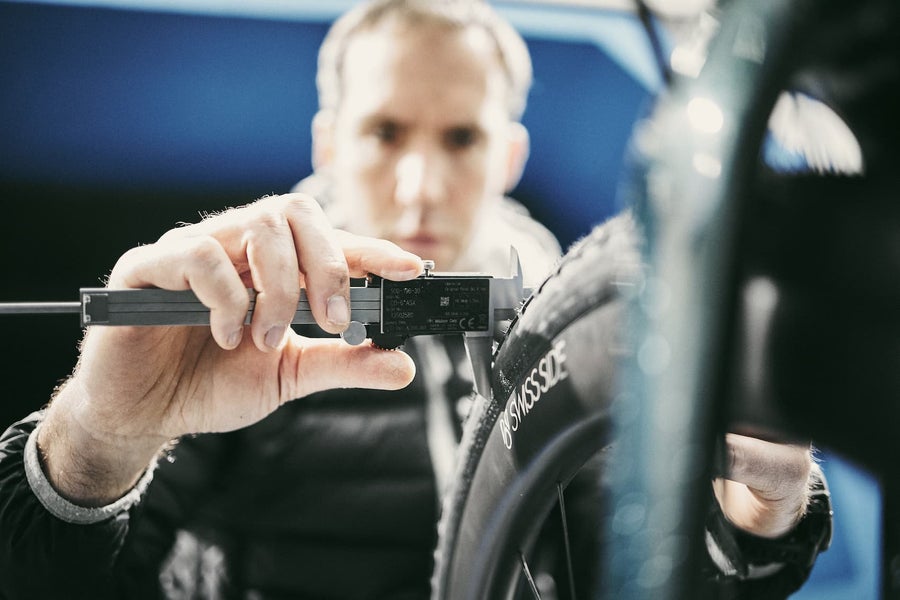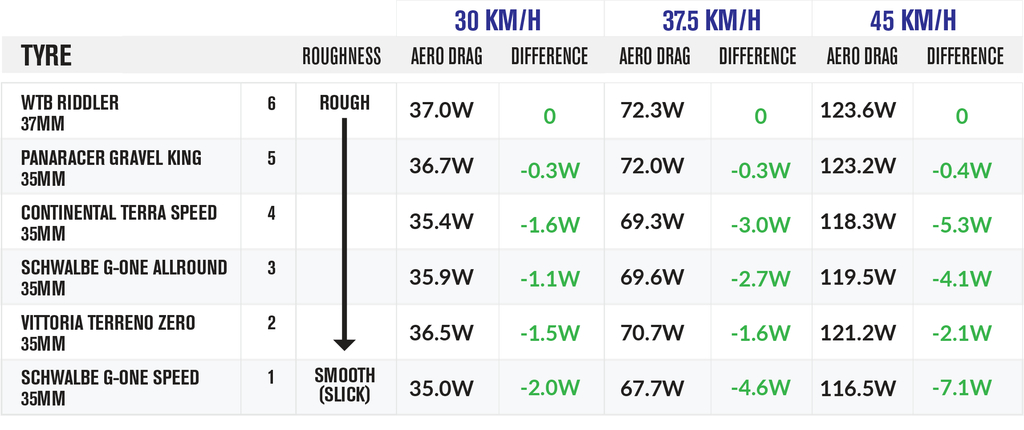Anti-sailing and knob-induced drag: Swiss Side delves into gravel tyre aerodynamics
Aero experts test Continental, Panaracer, Schwalbe, Vittoria and WTB tyres using its newest carbon gravel wheelset, the Gravon 420

Swiss Side has launched two new gravel wheelsets, and with it, a report on the aerodynamic drag of various gravel tyres when ridden at different speeds.
With gravel racing continuing to grow in popularity, and brands releasing more and more ‘fast’ gravel bikes such as Specialized’s S-Works Crux, the results from the German wind tunnel make interesting reading.
The report starts by setting a context. In this case comparing the performance of a road bike and gravel bike to find the ‘base penalty’ in resistance, which is a combination of aero drag and rolling resistance.
For anyone who’s ridden a gravel bike on the road it’s no shock that it has more resistance than a typical road bike set-up. According to Swiss Side this equates to around a 40W increase at 30km/h, with aero drag and rolling resistance contributing equally to this penalty in performance. As you might expect, this gap widens as the speed increases - at 45km/h the difference between the bikes has grown to over 90W.

However, the impact of aero drag figures more highly into the equation as cross-wind angles intensify. Swiss Side’s findings shows that while aero road bikes are designed to ‘sail’ in crosswinds, gravel frames, devoid of aero tubing, can have an ‘anti-sail’ effect.
Next, using its new Gravon 250 and Gravon 420 wheels, Swiss Side compares a ‘bad’ gravel wheel and tyre set up with a ‘good’ one so as to quantify the potential savings in aero drag.
The ‘Best’ setup featured its 420 wheel, named for its 42mm rim depth, shod with Schwalbe’s G-One Speed 35mm tyre, while the ‘Worst’ setup used the shallower 250 wheels with Schwalbe G-One Allround 45mm tyre.
The latest race content, interviews, features, reviews and expert buying guides, direct to your inbox!
Naturally the deeper section rims have less aero drag to begin with - 1.8W at 30km/h, 3.0W at 37.5km/h and 5.4W at 45km/h according to Swiss Side’s results, with both wheels fitted with the same 40mm Schwalbe G-One Allround tyres.
Factor in the different tyres and these numbers increase. The ‘Best’ set up saves 5W at 30km/h, 11W at 37.5km.h and 20W at 45km/h.
The numbers certainly appear significant and to provide some ‘real-race’ context, Swiss Side looked to the 2021 Unbound Gravel 200 race.
At this event, which is 206 miles long and packs in over 3000m of climbing, the top riders finished in just over 10 hours with an average speed of 32km/h. The claimed 5W saving between the ‘good’ and ‘bad’ setups would equate to 8.5 minutes.
Considering that the top four riders in the race were separated by 1.5 minutes and you can quickly see how the right, or indeed wrong, wheel and tyre set up can impact your race performance.
The obvious difference between the two setups besides rim depth is in the width of the tyres. Swiss Side’s results show that a wider tyre both increases aero drag and reduces the sailing effect.

But how does the tread pattern impact the numbers? When we’re choosing the best gravel tyres we know that we need to weigh up the tyre’s ability to provide sufficient grip off-road with its rolling resistance on-road. In short, the number and the profile of the knobs will likely change depending on the terrain you plan on riding.
So what is the correlation between a ‘rougher’ tread pattern (with higher knobs) on gravel tyres and increased drag? To find out Swiss Side selected a number of popular 35-37mm gravel tyres with different tread patterns from Continental, Panaracer, Schwalbe, Vittoria and WTB and headed to the wind tunnel. All tyres were tested using Swiss Side’s Gravon 420 carbon wheels on a Cervélo Aspero gravel bike.
As you might expect, the tyres with larger and higher knobs created more drag, with a reduced sailing effect to boot. The WTB Riddler had the most aggressive tread pattern of the chosen tyres. According to Swiss Side’s results this translated to a 2W penalty at 30km/h compared to the Schwalbe G-One Speed tyre, the slickest and fastest of the bunch.

The only real anomaly during testing was the performance of Continental’s Terra Speed tyre. It was the third ‘knobbliest’ among the six tyres yet there was only a 0.4W difference at 30km/h to Schwalbe’s G-One Speed.
Based on these tests the clear takeaway is that when it comes to gravel tyres we must accept a compromise between grip and aero drag.
However, with ‘gravel’ far from being universal in its make-up, how much attention is paid to aerodynamics will vary greatly from one rider to the next. Certainly the ‘claggy’ conditions found across much of the UK’s paths and trails at this time year calls for greater traction, not less. Time perhaps to head out of the wind tunnel and into some real dirt in the pursuit of the perfect gravel tyre.
Luke Friend has worked as a writer, editor and copywriter for over twenty five years. Across books, magazines and websites, he's covered a broad range of topics for a range of clients including Major League Baseball, Golf Digest, the National Trust and the NHS. He has an MA in Professional Writing from Falmouth University and is a qualified bicycle mechanic. He has been a cycling enthusiast from an early age, partly due to watching the Tour de France on TV. He's a keen follower of bike racing to this day as well as a regular road and gravel rider.